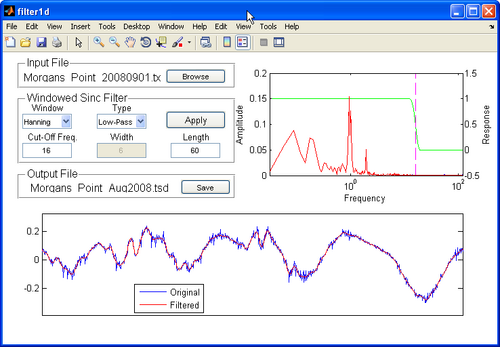Utilities: Difference between revisions
Jump to navigation
Jump to search
No edit summary |
|||
| Line 8: | Line 8: | ||
<br style="clear:both" /> | <br style="clear:both" /> | ||
[[File:TAPtides.png|thumb|right|500px|TAP Interface]] | |||
* [[Media:TAP.rar | TAP: Tidal Analysis and Prediction software]] | * [[Media:TAP.rar | TAP: Tidal Analysis and Prediction software]] | ||
** TAPtides is the ideal package to explore and develop preliminary or finalized tidal predictions from serial records spanning several weeks to several months. | |||
** Designed to be easy to use, its Graphical User Interface permits quick separation of a time series of water level measurements | |||
into its tidal and non-tidal components using a selective least squares harmonic reduction employing up to 35 tidal constituents. | |||
** After saving the tidal constants for the constituents selected during analysis, the user can generate predictions of the astronomical tide, the | |||
water level that varies at known tidal frequencies attributable to gravitational interactions between the earth, moon, and sun. | |||
<br style="clear:both" /> | |||
== Post-processing == | == Post-processing == | ||
* [[proc_flux | Sediment transport integration tool]] | * [[proc_flux | Sediment transport integration tool]] | ||
Revision as of 16:20, 24 May 2010
Time Series Analysis

- Filter1D: Time Series Analysis Tool
- The Matlab utility provides users of the SMS, a one-stop package for preparing model input time series and allows users to interpolate, resample, filter, and transform any type of model forcing and supports SMS compatible file formats for ease of data transfer.
- The main feature of the software is the ability to apply high-pass, low-pass, band-pass, and band-stop filters to time series.
- There are many types of filters available, and each have their own advantages and disadvantages.
- Filter1D uses a windowed sinc filter which is a non-recursive finite impulse response filter.

- TAP: Tidal Analysis and Prediction software
- TAPtides is the ideal package to explore and develop preliminary or finalized tidal predictions from serial records spanning several weeks to several months.
- Designed to be easy to use, its Graphical User Interface permits quick separation of a time series of water level measurements
into its tidal and non-tidal components using a selective least squares harmonic reduction employing up to 35 tidal constituents.
- After saving the tidal constants for the constituents selected during analysis, the user can generate predictions of the astronomical tide, the
water level that varies at known tidal frequencies attributable to gravitational interactions between the earth, moon, and sun.